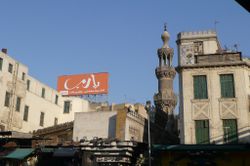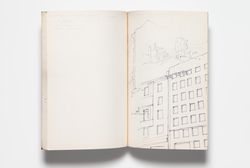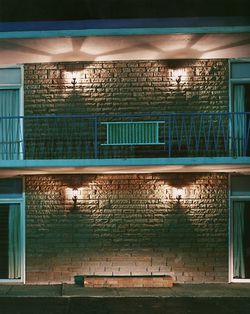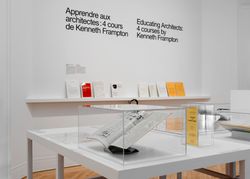documents textuels
AP197.S3.001
Description:
This box is comprised of personal and professional correspondence, organized in chronological order, from 1958- 1983. Correspondence documents the beginning of Frampton's professional career and includes letters from his time as: a tutor at the Royal College of Art; the technical editor of the magazine Architectural Design; a visiting professor at Princeton University; an associate professor and, subsequently, Ware Professor of the Graduate School of Architecture, Planning and Preservation; a Fellow of the Institute for Architecture and Urban Studies; and an editor of Oppositions. This correspondence includes a letter inviting Frampton to teach at Princeton University and his acceptance of the position, his appointment to the Loeb Fellowship, and his appointment as an Associate Professor at Columbia University as well as correspondence concerning the first and second editions of Modern Architecture: a critical history. Throughout this period, Frampton corresponded with various architects, professors, publishers, and editors of various publications such as: Peter Eisenman; Robert Vickery; Anthony Hill; Melvin Charney; Richard Meier; Max Bill; Panos Koulermos; Tadao Ando; Tomás Maldonado; Manfredo Tafuri; Arata Isozaki; the Casabella; Architecture and Urbanism; DOMUS; and Thames and Hudson. Activities documented in this box include: various offers of teaching positions; requests to write articles, reviews, books and recommendation letters; invitations to attend or present lectures/symposiums/conferences; and requests to serve on juries.
1958-1984
Personal and professional correspondence from 1958-1984
Actions:
AP197.S3.001
Description:
This box is comprised of personal and professional correspondence, organized in chronological order, from 1958- 1983. Correspondence documents the beginning of Frampton's professional career and includes letters from his time as: a tutor at the Royal College of Art; the technical editor of the magazine Architectural Design; a visiting professor at Princeton University; an associate professor and, subsequently, Ware Professor of the Graduate School of Architecture, Planning and Preservation; a Fellow of the Institute for Architecture and Urban Studies; and an editor of Oppositions. This correspondence includes a letter inviting Frampton to teach at Princeton University and his acceptance of the position, his appointment to the Loeb Fellowship, and his appointment as an Associate Professor at Columbia University as well as correspondence concerning the first and second editions of Modern Architecture: a critical history. Throughout this period, Frampton corresponded with various architects, professors, publishers, and editors of various publications such as: Peter Eisenman; Robert Vickery; Anthony Hill; Melvin Charney; Richard Meier; Max Bill; Panos Koulermos; Tadao Ando; Tomás Maldonado; Manfredo Tafuri; Arata Isozaki; the Casabella; Architecture and Urbanism; DOMUS; and Thames and Hudson. Activities documented in this box include: various offers of teaching positions; requests to write articles, reviews, books and recommendation letters; invitations to attend or present lectures/symposiums/conferences; and requests to serve on juries.
documents textuels
1958-1984
L'enseignement du... Caire
Nasser Rabbat questionne la définition binaire opposant l’Orient et l’Occident ou encore le traditionnel et le moderne, et aborde la relation dialectique entre modernité et histoire dans la composition de la ville contemporaine du Caire. Façonnée par différentes périodes de modernité, depuis l’invasion coloniale napoléonienne de 1789 jusqu’à la révolution et(...)
Théâtre Paul-Desmarais
15 septembre 2011 , 19h
L'enseignement du... Caire
Actions:
Description:
Nasser Rabbat questionne la définition binaire opposant l’Orient et l’Occident ou encore le traditionnel et le moderne, et aborde la relation dialectique entre modernité et histoire dans la composition de la ville contemporaine du Caire. Façonnée par différentes périodes de modernité, depuis l’invasion coloniale napoléonienne de 1789 jusqu’à la révolution et(...)
Théâtre Paul-Desmarais
Le chercheur en résidence Gregorio Carboni Maestri présente sa recherche. Des années 1930 à la fin des années 1980, l’architecture portugaise s’est construite sur une relation frustrante avec la modernité, et sur un dialogue crucial avec l’Italie. Ce séminaire portera sur la façon dont l’architecture portugaise a observé les modèles italiens et y a réagi, notamment le(...)
Maison Shaughnessy Mot(s)-clé(s):
Gregorio Carboni Maestri, chercheur en résidence, Portugal, Tendenza
3 août 2017, 18h
Séminaire de chercheur en résidence : Gregorio Carboni Maestri
Actions:
Description:
Le chercheur en résidence Gregorio Carboni Maestri présente sa recherche. Des années 1930 à la fin des années 1980, l’architecture portugaise s’est construite sur une relation frustrante avec la modernité, et sur un dialogue crucial avec l’Italie. Ce séminaire portera sur la façon dont l’architecture portugaise a observé les modèles italiens et y a réagi, notamment le(...)
Maison Shaughnessy Mot(s)-clé(s):
Gregorio Carboni Maestri, chercheur en résidence, Portugal, Tendenza
Barbara Penner, historienne de l’architecture, retrace l’évolution des Chutes du Niagara, de leur statut de destination phare pour jeunes mariés au XIXe siècle à celui d’icône postindustrielle kitsch, avant de redevenir la destination par excellence des jeunes mariés. Le photographe Alec Soth, dont les travaux constituent l’amorce de cette causerie présentée par Barbara(...)
Théâtre Paul-Desmarais
23 avril 2009
L'enseignement de... Niagara Falls
Actions:
Description:
Barbara Penner, historienne de l’architecture, retrace l’évolution des Chutes du Niagara, de leur statut de destination phare pour jeunes mariés au XIXe siècle à celui d’icône postindustrielle kitsch, avant de redevenir la destination par excellence des jeunes mariés. Le photographe Alec Soth, dont les travaux constituent l’amorce de cette causerie présentée par Barbara(...)
Théâtre Paul-Desmarais
Lors de la réforme de l’enseignement dans les écoles d’architecture américaines durant les années 1970, Kenneth Frampton a joué un rôle de premier plan dans la transformation du programme de la Graduate School of Architecture Planning de Columbia University. Il a notamment créé et enseigné les trois cours de base du programme: le séminaire théorique «Comparative Critical(...)
Salle octogonale Mot(s)-clé(s):
Kenneth Frampton, Columbia, Princeton, teaching, GSAPP
31 mai 2017 au 24 septembre 2017
Apprendre aux architectes : quatre cours de Kenneth Frampton
Actions:
Description:
Lors de la réforme de l’enseignement dans les écoles d’architecture américaines durant les années 1970, Kenneth Frampton a joué un rôle de premier plan dans la transformation du programme de la Graduate School of Architecture Planning de Columbia University. Il a notamment créé et enseigné les trois cours de base du programme: le séminaire théorique «Comparative Critical(...)
Salle octogonale Mot(s)-clé(s):
Kenneth Frampton, Columbia, Princeton, teaching, GSAPP
archives
Niveau de description archivistique:
Collection
CD042
Résumé:
The collection documents the research of Susan Wagg, one of the curators of the exhibition “Money Matters: A Critical Look at Bank Architecture”, on bank buildings in the United States and in Canada, from 1795 to 1979. It contains her research files on each of the bank buildings presented in the exhibition and the photograhic commission of the banks by photographers Robert Bourdeau, Edward Burtynsky, David Duchow, David Miller, Marilyn Bridges, James Iska, Len Jenshel, John Pfahl, George Tice, Catherine Wagner and Serge Hambourg.
1926-1993
Collection de l’exposition Money Matters
Actions:
CD042
Résumé:
The collection documents the research of Susan Wagg, one of the curators of the exhibition “Money Matters: A Critical Look at Bank Architecture”, on bank buildings in the United States and in Canada, from 1795 to 1979. It contains her research files on each of the bank buildings presented in the exhibition and the photograhic commission of the banks by photographers Robert Bourdeau, Edward Burtynsky, David Duchow, David Miller, Marilyn Bridges, James Iska, Len Jenshel, John Pfahl, George Tice, Catherine Wagner and Serge Hambourg.
archives
Niveau de description archivistique:
Collection
1926-1993
expositions
Les termes contemplation, désert, exil, loisir, repos, retraite, rêverie, solitude et leurs antonymes, action, cour, monde, mondanité, société, constituent un champ lexical fortement utilisé dans la littérature de fiction et la littérature biographique du XVIIe siècle. L’exposition conjugue histoire, littérature et architecture, s’attachant en particulier au thème de la(...)
Vitrines
12 octobre 1994 au 15 janvier 1995
De la ville au désert : espaces publics et privés dans la France du XVIIe siècle
Actions:
Description:
Les termes contemplation, désert, exil, loisir, repos, retraite, rêverie, solitude et leurs antonymes, action, cour, monde, mondanité, société, constituent un champ lexical fortement utilisé dans la littérature de fiction et la littérature biographique du XVIIe siècle. L’exposition conjugue histoire, littérature et architecture, s’attachant en particulier au thème de la(...)
expositions
12 octobre 1994 au
15 janvier 1995
Vitrines
archives
Niveau de description archivistique:
Fonds
Fonds Ross & Macdonald
AP013
Résumé:
The Ross & Macdonald fonds is comprised of documents concerning the work of six successive architectural firms: Ross & MacFarlane (1905-1912), Ross & Macdonald (1913-1944), Ross & Ross (1944-1946), Ross, Patterson, Townsend & Heughan (1946-1950), Ross, Patterson, Townsend & Fish (1950-1958), and Ross, Fish, Duschenes & Barrett (1958-1976). The greatest concentration of work was produced in Montreal where each of the firms maintained their head office, but there were also a large number of works executed in New Brunswick and Nova Scotia. The fonds contains 27 884 drawings (24 294 originals plus 3 590 reproductions), 236 photographs, and 18.6 metres of textual documents.
1902-1982
Fonds Ross & Macdonald
Actions:
AP013
Résumé:
The Ross & Macdonald fonds is comprised of documents concerning the work of six successive architectural firms: Ross & MacFarlane (1905-1912), Ross & Macdonald (1913-1944), Ross & Ross (1944-1946), Ross, Patterson, Townsend & Heughan (1946-1950), Ross, Patterson, Townsend & Fish (1950-1958), and Ross, Fish, Duschenes & Barrett (1958-1976). The greatest concentration of work was produced in Montreal where each of the firms maintained their head office, but there were also a large number of works executed in New Brunswick and Nova Scotia. The fonds contains 27 884 drawings (24 294 originals plus 3 590 reproductions), 236 photographs, and 18.6 metres of textual documents.
archives
Niveau de description archivistique:
Fonds
1902-1982
articles
Trajets et transferts
Mrinalini Rajagopalan retrace l’histoire du Fort rouge à Delhi, de sa destruction par les Britanniques en 1857, jusqu’à leurs efforts déployés pour préserver et protéger l’édifice. Cliquez ici pour consulter la liste complète des séminaires de l’été.
Maison Shaughnessy
8 juillet 2010
Séminaire de chercheur en résidence : Mrinalini Rajagopalan
Actions:
Description:
Mrinalini Rajagopalan retrace l’histoire du Fort rouge à Delhi, de sa destruction par les Britanniques en 1857, jusqu’à leurs efforts déployés pour préserver et protéger l’édifice. Cliquez ici pour consulter la liste complète des séminaires de l’été.
Maison Shaughnessy




